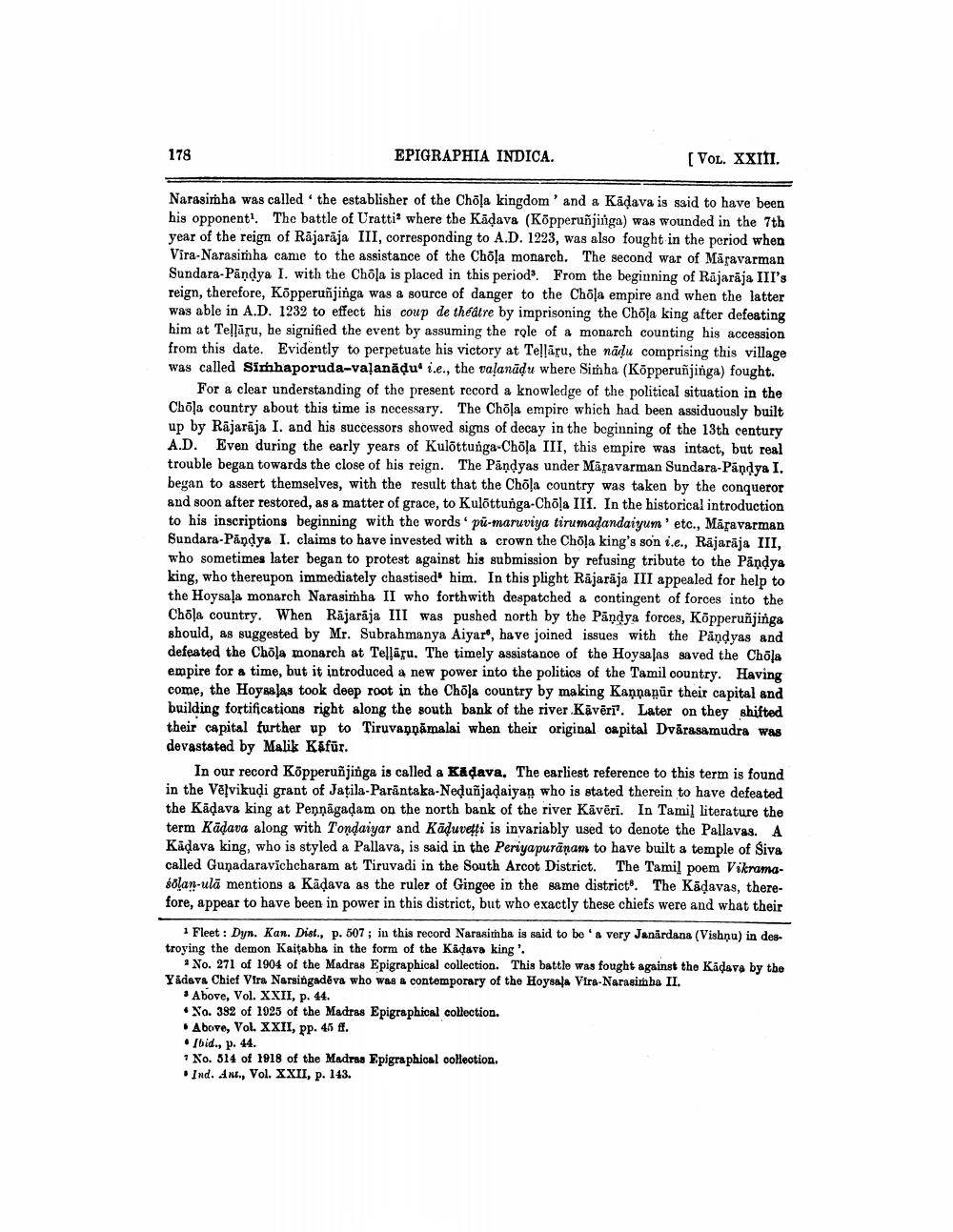________________
178
EPIGRAPHIA INDICA.
[Vol. XXII.
Narasimha was called the establisher of the Chāļa kingdom' and a Kādava is said to have been his opponent'. The battle of Uratti' where the Kādava (Köpperuñjiiga) was wounded in the 7th year of the reign of Rājarāja III, corresponding to A.D. 1223, was also fought in the period when Vira-Narasimha came to the assistance of the Chõļa monarch. The second war of Māravarman Sundara-Pandya I. with the Chola is placed in this period'. From the beginning of Rajarāja III's reign, therefore, Köpperunjinga was a source of danger to the Chola empire and when the latter was able in A.D. 1232 to effect his coup de théâtre by imprisoning the Chola king after defeating him at Tellūgu, be signified the event by assuming the role of a monarch counting his accession from this date. Evidently to perpetuate his victory at Telläru, the näddu comprising this village was called Simhaporuda-vaļanadu' i.e., the valanādu where Simha (KÕpperuñjinga) fought.
For a clear understanding of the present record a knowledge of the political situation in the Chõļa country about this time is necessary. The Chola empire which had been assiduously built up by Rājarāja I. and his successors showed signs of decay in the beginning of the 13th century A.D. Even during the early years of Kulõttunga-Chēļa III, this empire was intact, but real trouble began towards the close of his reign. The Pāņdyas under Māravarman Sundara-Pandya I. began to assert themselves, with the result that the Chola country was taken by the conqueror and soon after restored, as a matter of grace, to Kulõttunga-Chola III. In the historical introduction to his inscriptions beginning with the words 'pu-maruviya tirumadandaiyum' etc., Māravarman Sundara-Pandya I. claims to have invested with a crown the Choļa king's son i.e., Rājarāja III, who sometimes later began to protest against his submission by refusing tribute to the Pāņdya king, who thereupon immediately chastised' him. In this plight Rājarāja III appealed for help to the Hoysala monarch Narasimha II who forth with despatched a contingent of forces into the Chöļa country. When Rājarāja III was pushed north by the Pandya forces, KÕpperuñjinga should, as suggested by Mr. Subrahmanya Aiyar", have joined issues with the Pandyas and defeated the Chola monarch at Telläru. The timely assistance of the Hoysalas saved the Chola empire for a time, but it introduced a new power into the politics of the Tamil country. Having come, the Hoynalas took deep root in the Chola country by making Kannaŋür their capital and building fortifications right along the south bank of the river Kāvēri”. Later on they shifted their capital further up to Tiruvannamalai when their original capital Dvārasamudra was devastated by Malik Kafür.
In our record Köpperuñjinga is called a Kadava. The earliest reference to this term is found in the Vē vikudi grant of Jatila-Parantaka-Neduñjadaiyan who is stated therein to have defeated the Kādava king at Pennāgadam on the north bank of the river Kāvēri. In Tamil literature the term Kādava along with Tondaiyar and Käduvetti is invariably used to denote the Pallavas. A Kadava king, who is styled a Pallava, is said in the Periyapurānam to have built a temple of Siva called Gunadaravichcharam at Tiruvadi in the South Arcot District. The Tamil poem Vikramasolan-ulā mentions a Kādava as the ruler of Gingee in the same district. The Kādavas, therefore, appear to have been in power in this district, but who exactly these chiefs were and what their
1 Fleet : Dyn. Kan. Dist., p. 507; in this record Narasimha is said to be a very Janardana (Vishnu) in destroying the demon Kaitabha in the form of the Kadava king'.
* No. 271 of 1904 of the Madras Epigraphical collection. This battle was fought against the Kādava by the Yådeva Chief Vira Narsingadēva who was a contemporary of the Hoysala Vira-Narasimha II.
* Above, Vol. XXII, p. 44. • Xo. 382 of 1025 of the Madras Epigraphical collection. . Above, Vol. XXII, pp. 45 ff. • Ibid., p. 44. * No. 514 of 1918 of the Madras Epigraphical collection. . Ind. Ant., Vol. XXII, p. 143.




